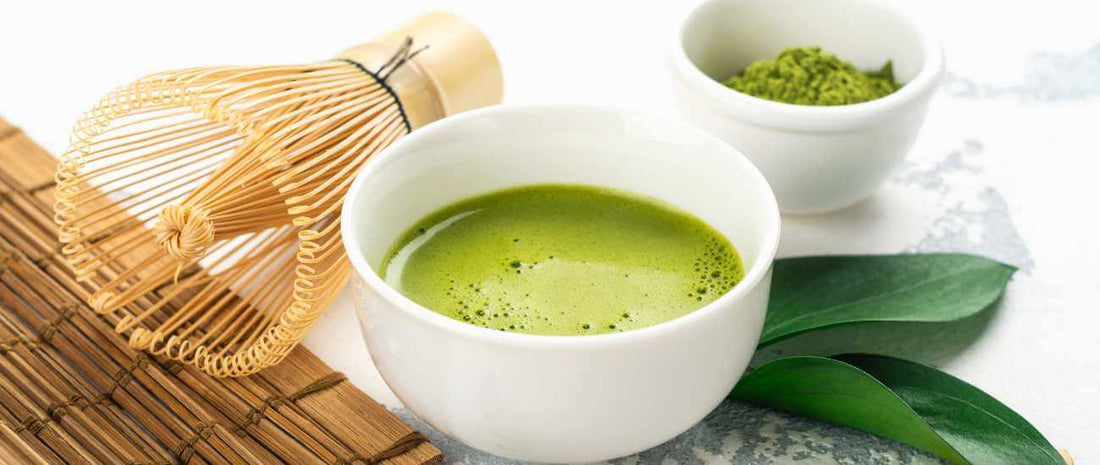
What is Matcha Tea?
Share
What Exactly is Matcha Tea? In the realm of teas, where tradition meets innovation, matcha stands out as a vibrant and revered member. Originating from Japan, this powdered green matcha tea has transcended its cultural roots to become a global phenomenon, celebrated for its unique flavor profile, health benefits, and rich history.
In this exploration of matcha tea, we delve into its origins, production process, cultural significance, health advantages, and the modern adaptation of this ancient elixir.
Table of content
What is Matcha Green Tea?
Matcha Tea: What is it? Matcha green tea is a type of powdered green tea that originated in Japan. It is made from finely ground green tea leaves, specifically from the Camellia sinensis plant. The leaves are grown and processed differently from traditional green tea leaves.
To produce matcha, the tea plants are shaded from direct sunlight for several weeks before harvest. This process increases the chlorophyll content and enhances the production of amino acids, particularly L-theanine, which contributes to the tea's unique flavor profile and potential health benefits.
After harvesting, the leaves are steamed to prevent oxidation, dried, and then ground into a fine powder using traditional stone mills. This powder is vibrant green in color and has a slightly sweet, grassy flavor with a creamy texture.
Origins and History of Matcha Tea
Tea leaves were steamed and formed into bricks during the Tang Dynasty (618-907 CE) when matcha began. The Chinese Zen Buddhist monks embraced this new form of tea, appreciating its meditative qualities. However, it wasn't until the 12th century that matcha found its way to Japan, thanks to the monk Eisai, who introduced it as a key element of the Zen Buddhist rituals.
In Japan, matcha became synonymous with refinement and spirituality, evolving into the ceremonial drink associated with the iconic Japanese tea ceremony. Matcha has gained prominence over the centuries, and it has become a symbol of sophistication and status.
Production Process of Matcha Tea
What sets matcha apart is not just its history but also the meticulous process involved in its production. The journey from tea plant to powdered elixir is a labor-intensive art form.
The tea plants destined for matcha are shaded for about 20-30 days before harvest to increase chlorophyll levels, intensify the vibrant green color and enhance the amino acid content. Using granite mills, the leaves are stone-ground into a fine powder after being handpicked, steamed to prevent fermentation, dried, and stone-ground to prevent fermentation. Through this process, the essence of the entire tea leaf is captured in every sip.
Cultural Significance of Matcha Tea
Matcha is embodied in the Japanese tea ceremony, known as "chanoyu" or "sado." Rooted in Zen philosophy, the ceremony is a choreographed ritual where the preparation and consumption of matcha become a form of meditation, promoting mindfulness and spiritual presence.
Matcha is not just a beverage in Japanese culture; it symbolizes respect, purity, harmony, and tranquility. The act of sharing matcha in a tea ceremony is a social bond that transcends mere refreshment, creating a moment of connection and serenity. Get more matcha information by visiting Leigh Leaf.
Flavor Profile and Culinary Uses of Matcha Tea
Matcha's flavor is an intricate dance of sweet, bitter, and umami notes, with a velvety texture that coats the palate. Higher grades of matcha have a more nuanced and complex flavor. Ceremonial-grade matcha, made from the youngest leaves, is revered for its delicate taste and vibrant green color.
While matcha's traditional use is in the tea ceremony, its versatility has led to an array of culinary applications. From lattes and smoothies to desserts and savory dishes, matcha has found its way into contemporary cuisine, creating a fusion of tradition and innovation. Its unique flavor adds depth to everything from ice cream to pasta sauces, appealing to both purists and experimental food enthusiasts.
Modern Adaptation of Matcha Tea
In recent years, matcha has undergone a global renaissance, transcending its traditional roots to become a mainstream phenomenon. Its adaptation to modern lifestyles is evident in the proliferation of matcha-flavored products, from snacks and chocolates to skincare items.
Matcha's popularity has surged in the West, where it is not only consumed for its taste and health benefits but also embraced as a symbol of wellness and mindfulness. Matcha cafes have become trendy, offering a variety of matcha-infused beverages and treats, appealing to a diverse audience seeking a balance of flavor and well-being.
Selecting and Brewing Matcha
Matcha's full potential can only be realized when you choose the right brand. The highest quality is ceremonial grade, which comes in various grades. When choosing matcha, you should look for a vibrant green color, a fine texture, and an aroma of grassy freshness.
Matcha preparation is an art form in and of itself. Chasen (bamboo whisk) and chawan (bowl) are traditionally used. Stir the matcha until a frothy layer forms by sifting it, adding hot water, and stirring in a "W" or "M" shape. The result is a bowl of velvety green liquid, ready to be savored.
Conclusion
Matcha tea, with its rich history, intricate production process, cultural significance, and health benefits, is more than just a beverage—it's a cultural icon that has stood the test of time. Its journey from the ancient tea ceremonies of Japan to the bustling modern cafes worldwide exemplifies its adaptability and enduring appeal.
Whether enjoyed in a serene tea ceremony or blended into a contemporary latte, matcha continues to captivate tea enthusiasts and newcomers alike. As we savor each sip, we not only indulge in a delicious and invigorating drink but also connect with a tradition that spans centuries, embracing the harmony between nature, culture, and our well-being.
Related Article:




